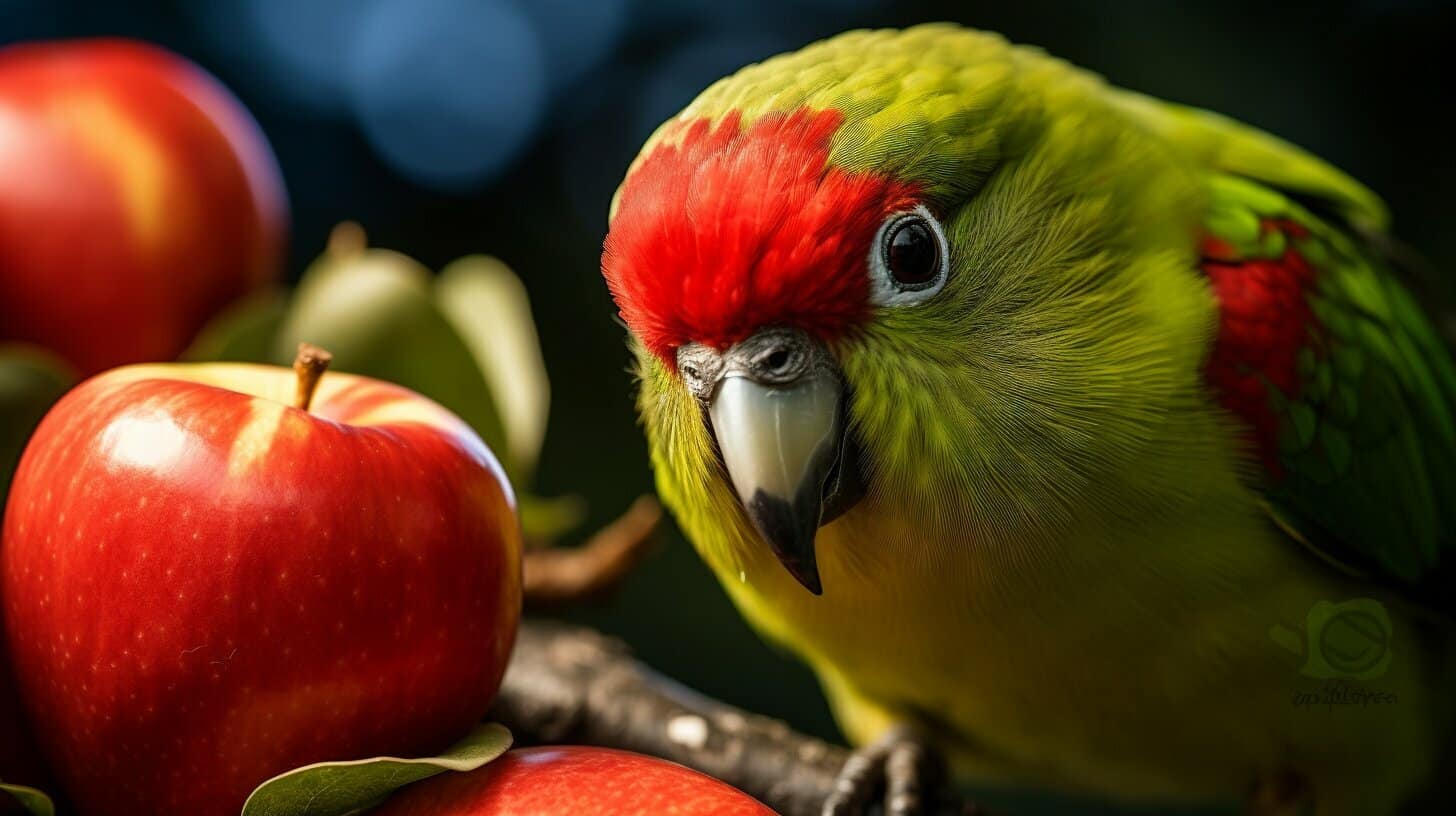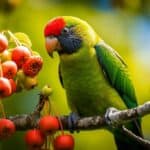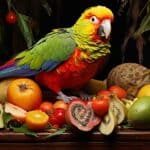Welcome to our article that answers the question can Kakarikis eat apples? and also discusses their favourite treats! These beautiful birds are known for their active and curious nature, and their diets play a crucial role in maintaining their health and wellbeing. In this article, we will explore whether Kakarikis can safely consume apples, as well as a range of other treats that they enjoy.
Can Kakarikis Eat Apples?
If you’re a kakariki owner, you may be wondering if your feathered friend can enjoy apples as part of their diet. The good news is that apples are considered safe for kakarikis to eat. In fact, many kakarikis enjoy the sweet taste and crunchy texture of apples, and they can be a nutritious addition to their diet.
However, it’s important to note that apples should be given to kakarikis in moderation, as too much fruit can lead to digestive issues or weight gain. As with any new food, it’s best to introduce apples gradually and monitor your kakariki for any adverse reactions.
When offering apples to your kakariki, be sure to wash them thoroughly and remove any seeds or core. The seeds of apples contain trace amounts of cyanide, which can be toxic to birds in large quantities.
Overall, apples can be a safe and enjoyable treat for your kakariki, but always remember to offer them in moderation and alongside a balanced diet of fruits, vegetables, proteins, and grains.
Nutritional Benefits of Apples for Kakarikis
Apples are not only safe for Kakarikis to eat, but they also offer a wealth of nutritional benefits. These fruits are an excellent source of vitamins, minerals, and antioxidants that can help keep your bird healthy and happy.
| Nutrient | Amount per 100g of Apples |
|---|---|
| Vitamin C | 5 mg |
| Vitamin K | 2.2 mcg |
| Potassium | 104 mg |
| Dietary Fiber | 2.4 g |
Vitamin C is a powerful antioxidant that can boost your Kakariki’s immune system and protect it against infections and diseases. Vitamin K plays a key role in blood clotting and bone health.
Potassium is essential for muscle and nerve function, while dietary fiber can aid in digestion and promote healthy bowel movements.
Just be sure to always wash your apples thoroughly before feeding them to your Kakariki, and remove any seeds or stems that could pose a choking hazard.
How to Introduce Apples to Kakarikis
If you’re wondering how to introduce apples to your Kakariki’s diet safely, it’s important to take a few precautions to avoid any potential digestive issues.
Step 1: Start by offering a small piece of apple as a treat, rather than a significant part of their diet. This will help you monitor their reaction to the fruit and avoid overfeeding.
Step 2: Wash and slice the apple into small pieces to make it easier for your bird to eat. Remove any seeds, as they can be toxic to birds.
Step 3: Monitor your Kakariki for any signs of digestive issues or allergic reactions after feeding them apple. If you notice any symptoms such as vomiting, diarrhea, or lethargy, remove the apple from their diet and consult your veterinarian.
Step 4: Gradually increase the amount of apple you offer your bird over time. While apples can be a healthy addition to their diet, it’s important to remember that they should still be eating a varied selection of fruits, vegetables, and other foods to maintain a balanced diet.
Remember, every bird is different, and some Kakarikis may not be interested in apples at all. If your bird doesn’t seem interested in this fruit, don’t worry – there are plenty of other safe and delicious treats you can offer them instead.
“Offering sliced apple on a skewer or a toy can also be a fun way to engage your Kakariki and provide them with some enrichment.”
Other Safe and Delicious Treats for Kakarikis
While apples can be a tasty addition to a Kakariki’s diet, there are plenty of other safe and delicious treats to offer your feathered friend. Here are a few options to consider:
| Treat | Benefits | Serving Size |
|---|---|---|
| Berries | High in antioxidants and vitamin C, which can support the immune system. | A few berries as a treat once or twice a week. |
| Leafy Greens | Packed with vitamins and minerals, such as vitamin K and calcium. | A few small pieces of leafy greens, such as kale or spinach, a few times a week. |
| Seeds | A good source of healthy fats and protein. | A small amount (no more than a teaspoon) once or twice a week. |
It’s important to note that treats should only make up a small portion of your Kakariki’s diet. The majority of their meals should consist of a balanced mix of fruits, vegetables, proteins, and grains. Offering a variety of foods will help ensure that they are getting all the nutrients they need to be happy and healthy.
Foods to Avoid Feeding Kakarikis
While Kakarikis can eat many safe and healthy foods, it’s important to be aware of potential hazards. Some foods can cause health problems or toxicity in these birds and should be avoided.
Here are some foods to steer clear of when feeding your Kakariki:
| Food | Reason to Avoid |
|---|---|
| Avocado | Contains persin, which can be toxic to birds and cause digestive problems. |
| Chocolate | Contains theobromine, which can be toxic to birds and cause heart problems, seizures, and even death. |
| Alcohol | Can cause liver damage, drunkenness, and other health problems. |
| Caffeine | Can cause hyperactivity, heart problems, and other health issues. |
| Salted or fatty foods | Can cause digestive problems and liver damage. |
Keep your Kakarikis happy and healthy by avoiding these foods and sticking to a well-balanced diet.
Offering a Balanced Diet to Kakarikis
As with any animal, offering a balanced diet to kakarikis is important to ensure they receive all the necessary nutrients for good health. A variety of fruits, vegetables, proteins, and grains can be included in their diet to achieve this balance.
Here’s a breakdown of the types of foods you can offer your kakarikis:
| Food Group | Examples |
|---|---|
| Fruits | Apples, berries, oranges, grapes, kiwi |
| Vegetables | Carrots, broccoli, kale, sweet potato, squash |
| Proteins | Eggs, cooked chicken, cooked beans, tofu |
| Grains | Brown rice, quinoa, whole grain bread, pasta |
It’s essential to offer a variety of foods within each group to ensure your kakarikis are receiving all the necessary nutrients. For example, rotating between different fruits like apples, berries, and oranges will provide a range of vitamins and minerals.
Remember to always wash fruits and veggies thoroughly before offering them to your kakarikis to remove any dirt or pesticides. Keep in mind that fruits like apples should be cut into small, manageable pieces to avoid choking hazards.
Portion Sizes for Kakarikis’ Diets
The amount of food your kakarikis need will depend on their size and activity level. A general guideline is to offer a daily mix of fruits, vegetables, and proteins that is roughly the same size as your kakarikis’ head. This can be divided into two meals per day.
It’s also important to avoid overfeeding your kakarikis, as this can lead to obesity and health issues. If you’re unsure how much to feed your bird, consult a veterinarian or avian specialist.
You can help ensure your kakarikis stay healthy and happy by offering a balanced and varied diet. Remember always to introduce new foods gradually and monitor their reactions for any signs of allergies or digestive issues.
Signs of Food Allergies or Digestive Issues in Kakarikis
Kakarikis are generally hardy birds, but as with any animal, they can experience digestive issues or food allergies. Here are some signs to watch out for:
- Vomiting: If your Kakariki starts to vomit after eating, it could indicate a food intolerance or allergy. In some cases, it may also indicate an infection or other illness.
- Diarrhoea: Loose, watery droppings may indicate that your bird is experiencing digestive trouble or has consumed something that doesn’t agree with them.
- Loss of appetite: If your Kakariki suddenly loses interest in food, it could be a sign that they’re not feeling well. Monitor their behaviour and seek veterinary advice if the refusal to eat persists for more than a day or two.
- Weight loss: If your bird is losing weight, it’s important to investigate the underlying cause. In some cases, weight loss can be a sign of illness or malnutrition.
If you suspect your Kakariki is experiencing digestive issues or a food allergy, it’s important to address the problem. This may involve removing certain foods from their diet or seeking advice from a veterinarian.
Note: Some birds are more prone to food allergies or digestive issues than others. If you’re introducing new foods to your Kakariki’s diet, it’s always a good idea to do so gradually to minimise the risk of adverse reactions.
What Do Kakarikis Eat in the Wild?
Kakarikis, also known as the red-crowned parakeet, are native to New Zealand and have a varied diet in the wild. Their diet primarily consists of seeds, fruits, berries, flowers, and leaves. They also consume insects and their larvae, making them opportunistic omnivores.
In the wild, Kakarikis feed on a wide range of plant species, including kanuka, manuka, and rimu. They also enjoy nectar from the flowers of kowhai and rata trees, as well as fruits like berries and pohutukawa. These parakeets are also known to consume the flowers of cabbage trees and flax plants.
Kakarikis are able to adapt their diets seasonally, depending on the availability of food in their natural habitat. During the winter, when seeds are scarce, they tend to consume more fruits and berries. In the summer, when flowers and seeds are abundant, they eat more of these items.
| Food Group | Examples |
|---|---|
| Seeds and Grains | Grass seeds, tree seeds, cereal grains |
| Fruits and Berries | Pohutukawa, berries, apples, citrus fruits |
| Flowers and Nectar | Kowhai, rata, flax, kanuka, manuka |
| Insects and Larvae | Beetles, moths, caterpillars, grasshoppers |
Overall, Kakarikis have a diverse and balanced diet in the wild, allowing them to obtain a variety of nutrients necessary for their health.
Common Questions about Kakariki Diets
As a Kakariki owner, you may have questions about your feathered friend’s best diet. Here are some common questions and answers to help guide you:
Can Kakarikis eat seeds?
Yes, seeds are a great addition to a Kakariki’s diet. However, it’s important to offer a variety of seeds and not rely on one type as the sole source of nutrition. Additionally, seeds should be given in moderation as they are high in fat.
What fruits can Kakarikis eat?
Kakarikis can enjoy a variety of fruits, including apples (in moderation), berries (such as strawberries, raspberries, and blueberries), grapes, and melons. Removing any seeds and cutting the fruit into small pieces is important to prevent choking.
Can Kakarikis eat nuts?
While nuts are not toxic to Kakarikis, they should be given in moderation due to their high fat content. It’s best to offer nuts as an occasional treat rather than a regular part of the diet.
How much food should I offer my Kakariki?
Kakarikis should have access to fresh food and water at all times. The amount of food offered will depend on the bird’s size and activity level. As a general rule, offer enough food to last throughout the day and remove any uneaten food at the end of the day to avoid spoiling.
Can Kakarikis eat human food?
Some human foods, such as cooked eggs, whole-grain bread, and cooked vegetables, are safe for Kakarikis. However, it’s important to avoid foods high in salt, sugar, or fat, as well as any foods toxic to birds.
What should I do if my Kakariki is not eating?
If your Kakariki is not eating, seeking veterinary care is important. Loss of appetite can be a sign of illness or injury, and prompt treatment can help prevent further complications.
Can Kakarikis eat avocado or chocolate?
No, both avocado and chocolate are toxic to Kakarikis and should be avoided.
Can Kakarikis Eat Avocado?
The answer is no – you should never feed avocado to your Kakariki. Avocado contains persin, a toxin that can be fatal to birds. While some birds may be able to tolerate small amounts of avocado flesh, the risks of feeding your Kakariki any part of an avocado outweigh the potential benefits.
Can Kakarikis Eat Chocolate?
No – chocolate is also off-limits for Kakarikis. Chocolate contains theobromine, a compound that is toxic to birds (and many other animals). Symptoms of theobromine poisoning include vomiting, tremors, seizures, and in severe cases, death. Even a small amount of chocolate can be dangerous for your Kakariki, so it’s best to avoid it altogether.
Remember, you can offer plenty of other safe and delicious treats your Kakariki. Stick to a balanced diet of fruits, vegetables, grains, and proteins, and always research a food before giving it to your bird to ensure that it’s safe. If you’re ever in doubt, consult your avian veterinarian for the best advice and care for your feathered friend.



Have comments or questions about this article? Then get involved!
Spotted an error or something we have missed? Let us know